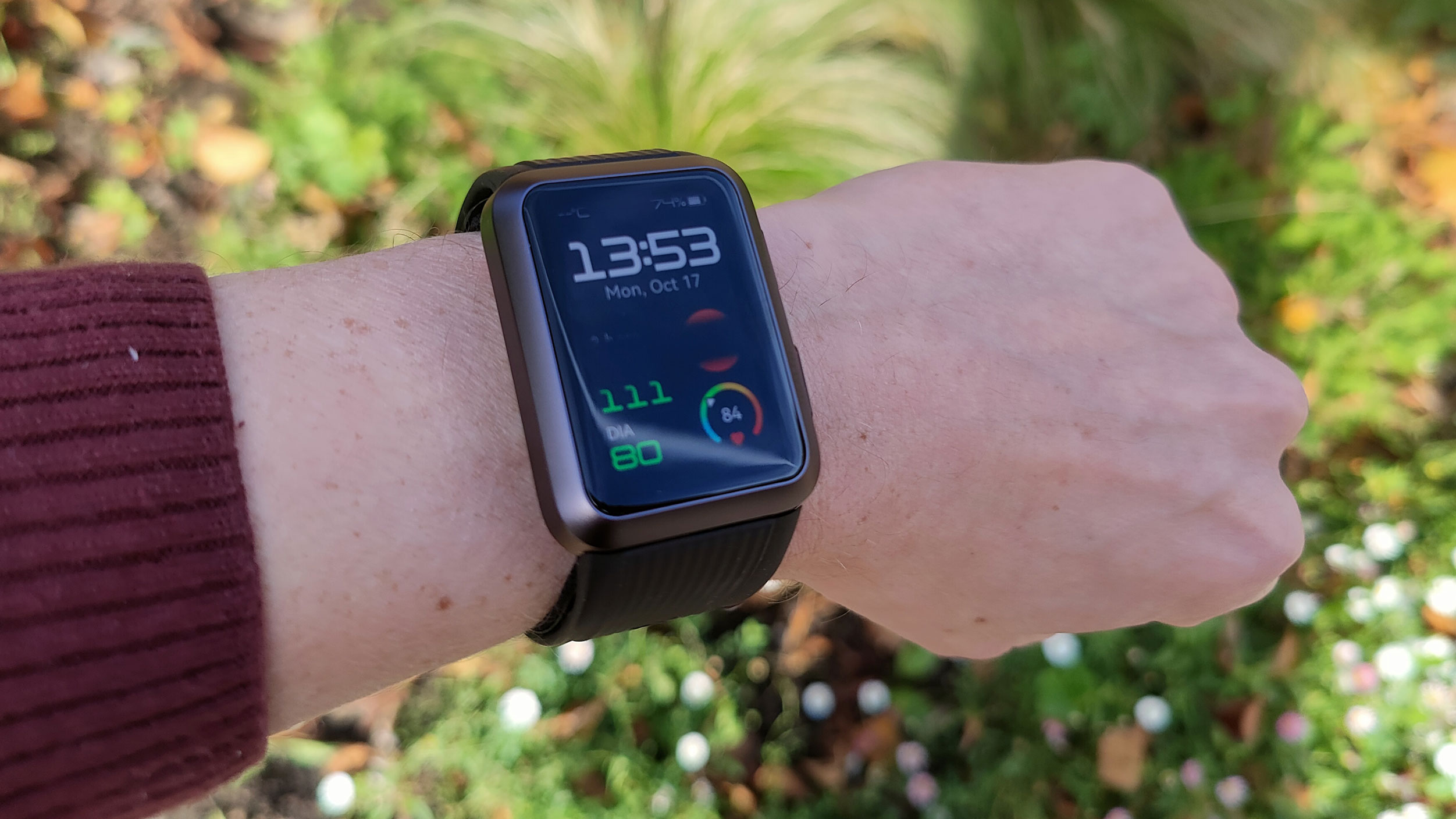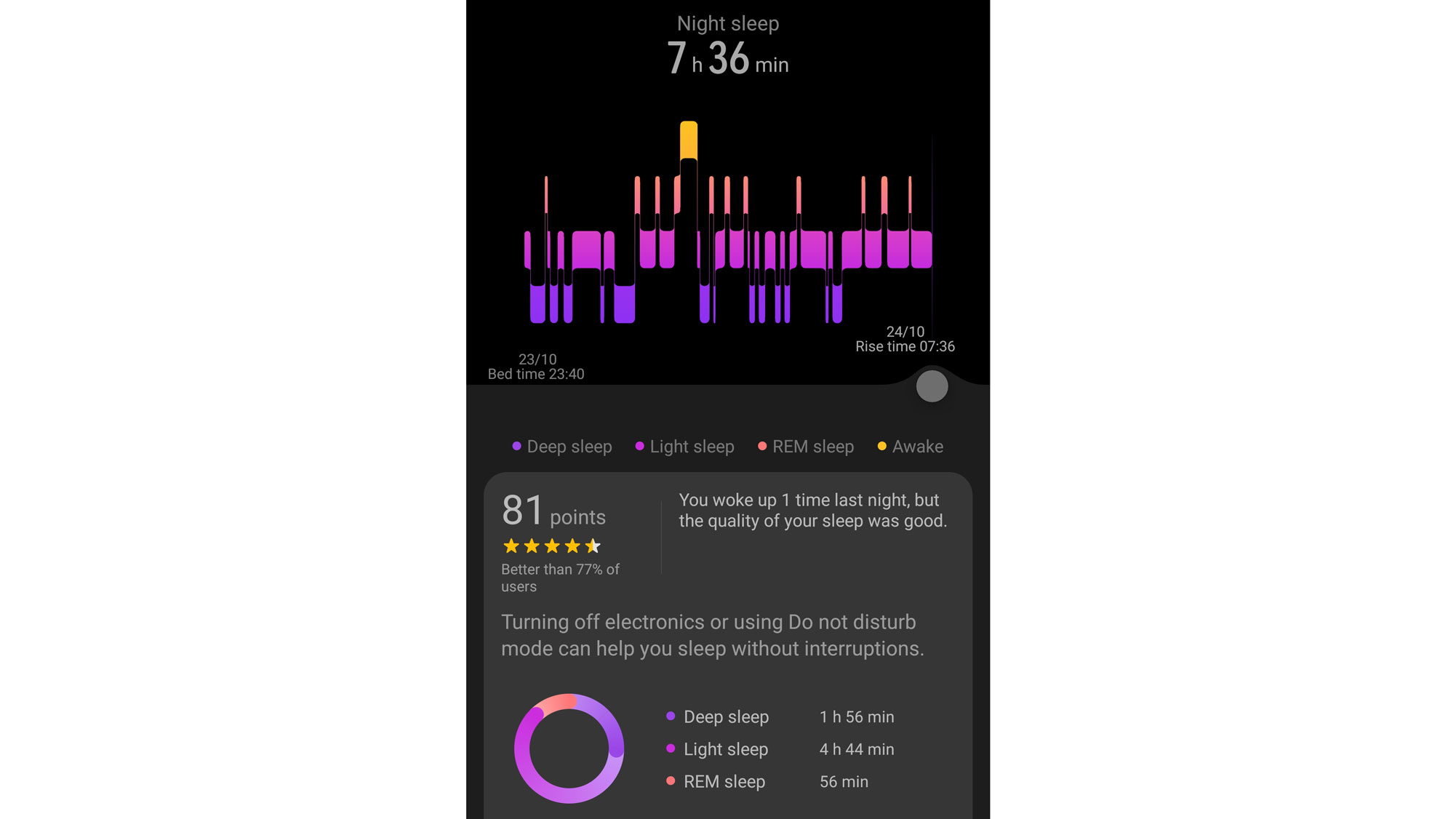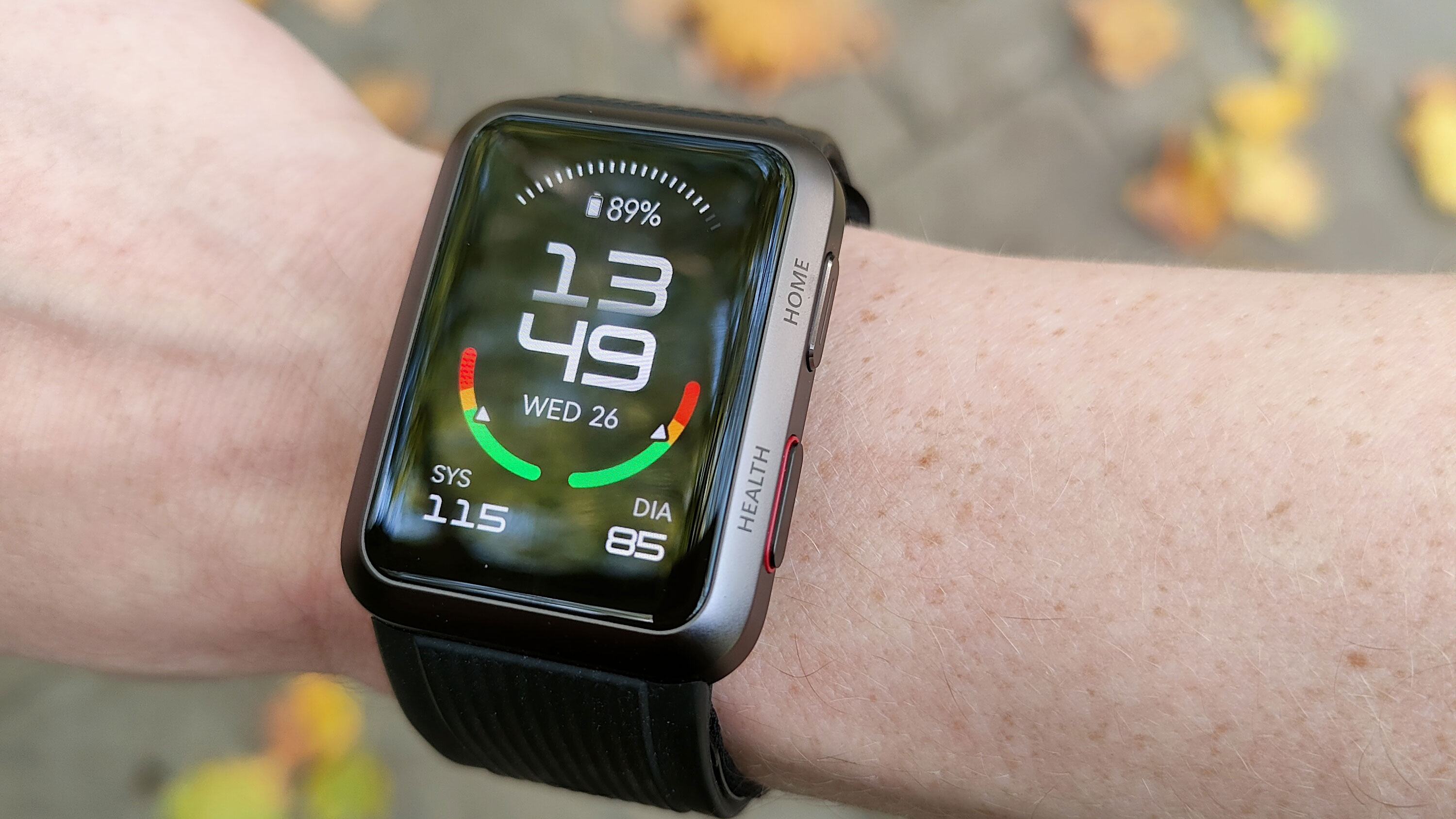TechRadar Verdict
The Huawei Watch D’s blood pressure monitoring is really something special, with the measuring done via inflatable sacs hidden inside the watch band. The watch performs admirably in other ways as well, with great battery life, solid smarts and good workout and sleep tracking features. The accompanying Huawei Health app is also intuitive and easy to use. However, this watch is not pretty enough to be a stylish fully-fledged smartwatch, nor comprehensive enough to challenge the best health watches out there.
Pros
- +
Blood pressure tech is neat
- +
Strong health and fitness features
- +
Well-designed companion app
Cons
- -
Big, boxy and somewhat ugly
- -
No music storage
- -
Feature-light compared to others in price range
Why you can trust TechRadar
There’s no getting around the Huawei Watch D’s main selling point, which is that it’s the first watch with blood pressure monitoring technology. This watch doesn’t just use an estimation based on a laser sensor; the Watch D incorporates an actual blood pressure cuff inside the watch band.
It’s a neat trick, a physical piece of hardware as opposed to yet another nondescript sensor, and I absolutely love the tactile nature of it. It’s the first thing in a long while that has me excited to show off my watch, kind of like a clip-on addition to a phone or a handheld games console from days of yore.
You can set timed reminders on your watch to make sure you take your blood pressure at regular intervals as part of a blood pressure management plan. The watch will register whether your blood pressure is elevated, low, and alerts you to the potential of a hypertensive crisis.
The watch isn’t medically certified and isn’t making diagnoses, but a Huawei spokesperson I chatted with explained that an alert is an indication to visit the doctor, rather than a medical-grade device on its own. This is the same official stance other companies like Fitbit and Apple take with their ECG functions, so no surprises here.
But there’s more to the Band D than the blood pressure cuff, and under the hood is a solid fitness watch with plenty to recommend it. It’s relatively feature-rich, and the Huawei Health app is comprehensive, with loads of great functionality. It’s a great watch, if not quite as feature-rich as the Garmins, Apple Watches and best running watches it’s vying against at its price point. The Watch itself is also remarkably boxy and unsightly, to be honest.

Huawei Watch D: Price and availability
The Huawei Watch D is available for £349.99 in the UK, with extremely limited availability in the US and Australia due to the ongoing dispute with China and its handling of data. It’s a good watch, but the £349.99 price tag puts it up there with some iterations of the best Apple Watch and Garmin’s mid-tier watches.
Huawei Watch D: Design and screen
- Ugly and boxy
- Feels premium
- Screen and interface are great
Let’s get this out of the way: the Huawei Watch D is ugly. It’s big and boxy, and sticks out horribly on the wrist, reminiscent of a calculator watch. 13.6mm deep doesn’t seem like a lot, but in practice, it’s the watch at its thinnest point, not at its thickest. It’s not a watch you’ll be wearing for style points. The size of it means that if the silicone strap is even slightly loose, the watch tends to move noticeably during runs.
However, it’s not too heavy — weighing 41 grams — just big. The case is black aluminium and graphite, so the watch feels and looks premium despite the design choices. The black band containing the blood pressure bladders is thick, but it sits comfortably on the wrists.
It’s not designed for looks, but for use, and it’s simple enough. The two-button design is simple to use on the fly, and I’m glad it’s got tactile buttons as they’re so much easier to use during workouts than touch-screens, which can be interrupted by sweat.
The 1.64 inches AMOLED color screen is great, big and bright and easy to see in light and dark environments alike. The interfaces of both the companion app, Huawei Health, and the watch’s UX are easy to use, although the watch attaches the “workout pause” function to the touchscreen rather than either of the two buttons, which are earmarked as “Home” and “Health”.
The wide silicone strap has a fabric inner, which is what contains those blow-up bladders used for the blood pressure technology. As previously mentioned, it’s a reassuringly physical design, but the dual-layering means sometimes during sweaty runs, the fabric slips if it’s slightly too loose, or itches if it’s slightly too tight.

- Design score: 3.5/5
Huawei Watch D: Features
- Good health-tracking features
- 70+ workout profiles
- Expected more at this price
The Huawei Watch D is good, but not overly feature-rich. The Health app offers comprehensive breakdowns of your sleep tracking, step count, blood pressure and heart rate data and organizes the information into historic graphs so it’s easy to read the trends. It’s good at providing actionable advice based on your data, although some of it was a little trite.
My light sleep score was a little high, so Huawei Health suggested cutting caffeine after midday, exercising more, and choosing suitable bedding. None of this advice feels particularly tailored to my needs, and I’ve read the same complaint on hundreds of blog posts.
The workout recommendations are better, especially in the running stakes. Huawei Health can take your data from the Watch D and provide detailed training plans and recommended workouts for any distance from 5K up to a full marathon.

The Watch D has 70+ workout profiles, a pretty comprehensive setup, including pool and open-water swimming. The Watch is IP68 protected against dust and water, making it safe to take for a dip.
The Watch can take ECG data, offers skin temp, stress tracking and blood oxygen in addition to Huawei’s TruSeen 5.0 heart rate monitoring tech. All of these can be triggered either manually, or be instructed via the app to collect the information automatically at certain points in your day.
It’s a good activity watch that does all the things you might expect it to do, but for its size, and its price point, you might expect a little more. There’s no music storage, only music control; no extra smart technology such as the Training Readiness or Body Battery scores of other brands; and it becomes quite clear after a few days that you’re paying extra for the still-new blood pressure attachments.
- Features score: 3/5
Huawei Watch D: Performance
- Love blood pressure technology
- Excellent battery life
- Daily Check-In seems invasive
The blood pressure technology is amazing, and I loved it. Huawei claims the Watch D “features a margin of error within ±3 mm Hg, made possible by a high-precision pressure sensor, meticulous pressure feedback controls, and less air-resistance”. We haven’t yet measured it against a medical-grade blood pressure cuff, but my BP was exactly within the range I expected it to be, and the data was consistent. It even includes a guest mode, because Huawei rightly guessed you’re going to want to excitedly strap the watch onto the wrists of your friends, family and spouse to show them what it can do.
The GPS during runs was accurate, for the most part, with a 0.3m/km difference in average pace when measured against the Apple Watch Ultra during a jaunt around Hyde Park. There was a slight difference in heart rate, probably due to the two watches being on different wrists, but both graphs matched up. I’d be comfortable relying on the Watch D for casual runs, but probably not for exact race times.
Elsewhere, the battery is excellent, with the Watch D lasting beyond its advertised seven-day limit with only light GPS and workout usage. It wasn’t always sleep tracking — because I’ve got a terrible habit of taking my watches off at night — but when it was, it offered the usual cocktail of light sleep, deep sleep, REM and times awake, matching up well with self observation, hardly draining the battery at all.
The Daily Health Check-In feature is an encouragement to monitor your blood pressure, check your weight and so on each day, and it’s useful to help the watch build up a baseline, but I dislike this insistence on checking these things daily: for many people, this can ironically lead to unhealthy habits. I would have liked to see something like Garmin’s Morning Report, which is far more useful. The Morning Report is specially geared towards detailing how you should train for the day while giving you other bits of important info like the weather.
I’m convinced that anyone using the Watch D will get a really comprehensive overview of their health. I can also see the blood pressure tech filtering its way down to other devices and brands in the shape of optional add-on bands (sold separately, of course). However, as a lifestyle companion, the Watch D didn’t grab me because of its uninspired design and high price point compared to other watches with similar features.
- Performance score: 4/5
Buy it if...
You want to take your blood pressure
This is a no-brainer. Want a blood pressure cuff incorporated into your smartwatch, along with ways to help you monitor BP at regular intervals? Get this watch.
You’re just getting into fitness
Huawei Health offers lots of data and ways to use it, recommending programs such as its beginner’s 5K plan, while monitoring all the vital aspects of your health.
Don't buy it if...
You’re already very fit
If you don’t need to take your blood pressure at regular intervals and you’re looking for a more comprehensive training companion, at this price we’d recommend a Garmin, Polar or Coros watch over the Watch D.
You want a cheaper watch
If you don’t want to make that hefty price tag, a cheaper watch or a fitness tracker with onboard GPS, such as the Fitbit Charge 5, will do the trick.
First reviewed October 2022

Matt is TechRadar's expert on all things fitness, wellness and wearable tech.
A former staffer at Men's Health, he holds a Master's Degree in journalism from Cardiff and has written for brands like Runner's World, Women's Health, Men's Fitness, LiveScience and Fit&Well on everything fitness tech, exercise, nutrition and mental wellbeing.
Matt's a keen runner, ex-kickboxer, not averse to the odd yoga flow, and insists everyone should stretch every morning. When he’s not training or writing about health and fitness, he can be found reading doorstop-thick fantasy books with lots of fictional maps in them.
